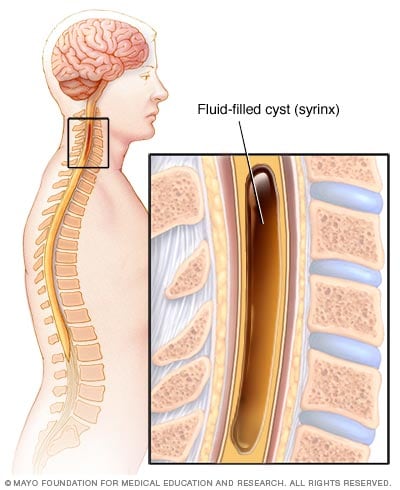Overview
Syringomyelia cyst (syrinx) in the spinal cord

Syringomyelia cyst (syrinx) in the spinal cord
Cerebrospinal fluid usually flows around the outside of the brain and spinal cord. In people with syringomyelia, cerebrospinal fluid collects inside the spinal cord and forms a fluid-filled cyst. The cyst is sometimes called a syrinx.
Syringomyelia (sih-ring-go-my-E-lee-uh) is the development of a fluid-filled cyst within the spinal cord. The cyst, which is sometimes called a syrinx, can grow larger over time. When it does, it can damage the spinal cord and cause pain, weakness and stiffness.
Syringomyelia has several possible causes. Many cases are associated with a Chiari malformation. This is a condition in which brain tissue pushes into the spinal canal.
Other causes of syringomyelia include spinal cord tumors, spinal cord injuries and damage caused by swelling around the spinal cord.
If syringomyelia doesn't cause problems, monitoring the condition might be all that's necessary. But if the symptoms are bothersome, surgery might be needed.
Products & Services
Symptoms
Syringomyelia symptoms usually develop slowly over time. If syringomyelia is caused by brain tissue pushing into the spinal canal, it is called a Chiari malformation. Symptoms generally begin between ages 25 and 40.
In some cases, coughing or straining can trigger symptoms of syringomyelia, although neither causes syringomyelia.
Syringomyelia might affect the back, shoulders, arms or legs. Symptoms can include:
- Muscle weakness and muscle wasting.
- Loss of reflexes.
- Loss of sensitivity to pain and temperature.
- Headaches.
- Stiffness in the back, shoulders, arms and legs.
- Pain in the neck, arms and back.
- Scoliosis. This is when the spine curves sideways.
When to see a doctor
If you have any of the symptoms associated with syringomyelia, see your healthcare professional.
If you've had a spinal cord injury, watch for symptoms of syringomyelia. It may take months to years after an injury before syringomyelia develops. Make sure your healthcare professional knows you had a spinal cord injury.
Causes
It's not clear how and why syringomyelia happens. When it develops, the fluid that surrounds, cushions and protects the brain and spinal cord collects within the spinal cord itself. This fluid is called cerebrospinal fluid. If it collects and forms a fluid-filled cyst, it is called a syrinx.
Several conditions and diseases can lead to syringomyelia, including:
- Chiari malformation, a condition in which brain tissue pushes into the spinal canal and blocks the regular flow of cerebrospinal fluid.
- Meningitis, which is swelling of the membranes surrounding the brain and spinal cord.
- Spinal cord tumor, which can interfere with the regular flow of cerebrospinal fluid.
- Conditions present at birth, such as a tethered spinal cord. A tethered spinal cord is a condition caused when tissue attached to the spinal cord limits its movement.
- Spinal cord injury, which can cause symptoms months or years later.
Complications
In some people, syringomyelia can progress and lead to serious complications. Other people have no symptoms.
A syrinx can cause complications if it grows or damages nerves within the spinal cord. Complications include:
- Scoliosis. This is when the spine curves sideways.
- Chronic pain resulting from damage to the spinal cord.
- Motor difficulties that can affect walking. Examples include weakness and stiffness in the leg muscles.
- Paralysis.